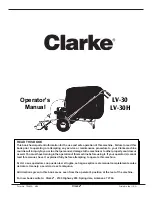
14
| English
Semi-automatic filter cleaning
The filter cleaning function should be activated at the very
latest when the suction power is no longer sufficient.
How often filter cleaning needs to be carried out will depend
on the type and quantity of dust that has been extracted.
With regular use, the maximum conveying capacity will be
maintained for longer.
– Switch the dust extractor off for 6–10 seconds and then
on again. Repeat this several times in succession.
The pre-filter
(22)
is cleaned using blasts of air when it is
switched off.
– To work after cleaning the filter, switch the dust extractor
back on.
Maintenance and service
Maintenance and Cleaning
u
Pull the plug out of the socket before cleaning or per-
forming maintenance on the vacuum cleaner, making
tool adjustments, changing accessories or putting
away the vacuum cleaner.
This safety measure prevents
the vacuum cleaner from being started accidentally.
u
To ensure safe and efficient operation, always keep
the dust extractor and the ventilation slots clean.
u
Wear a dust mask when servicing and cleaning the va-
cuum cleaner.
In order to avoid safety hazards, if the power supply cord
needs to be replaced, this must be done by
Bosch
or by an
after-sales service centre that is authorised to repair
Bosch
power tools.
GAS 12-25 PL
For the user to carry out maintenance, the dust extractor
needs to be disassembled, cleaned and maintained as far as
this is possible without endangering maintenance personnel
or other persons. Before disassembly, the dust extractor
should be cleaned to prevent any potential hazards. The
room/enclosure in which the dust extractor is disassembled
should be well ventilated. Wear personal protective equip-
ment while carrying out maintenance. After completing
maintenance, the maintenance area should be cleaned.
An inspection regarding the dust extraction capability must
be carried out at least once a year by the manufacturer or
someone who has been trained, e.g. to check for filter dam-
age, that the dust extractor is tight and that the control unit
is functioning correctly.
Class
L
dust extractors which were located in dirty environ-
ments should have their exteriors, as well as all their com-
ponents, cleaned or treated with sealant. When performing
maintenance and repair work, all dirty parts that cannot be
cleaned satisfactorily must be disposed of. Such parts must
be disposed of in impermeable bags in accordance with the
valid provisions for disposing of such waste.
– Clean the housing of the dust extractor occasionally with
a damp cloth.
– Clean dirty charging pins using a dry cloth.
Cleaning the container
– Wipe the container
(7)
from time to time using a non-ab-
rasive off-the-shelf cleaning product and leave it to dry.
Cleaning the Filters
Regularly emptying the dust container and cleaning the fil-
ters will ensure optimum suction power. If suction power is
not achieved after that, the vacuum cleaner is to be brought
to the after-sales service.
Cleaning the pre-filter
– Open the catches
(9)
and remove the top part of the va-
cuum cleaner
(10)
(see figure
C
).
– Take the pre-filter
(22)
out of the container
(7)
by its
handle
(28)
.
– Shake out the pre-filter
(22)
over a suitable waste bin.
– Insert the pre-filter
(22)
in the container
(7)
, making sure
that the arrow is pointing towards the hose connection
piece
(3)
.
– Put the top part of the vacuum cleaner
(10)
on and close
the catches
(9)
.
Cleaning the main filter
– Open the catches
(9)
and remove the top part of the va-
cuum cleaner
(10)
(see figure
C
).
– Turn the filter holder
(29)
as far as possible in the direc-
tion of rotation
and take the filter holder, together with
the main filter
(20)
, out of the top part of the dust
extractor
(10)
.
– Brush the folds of the main filter
(20)
with a soft brush.
or
Replace the main filter
(20)
if damaged.
– Place the filter holder
(29)
, together with the main filter
(20)
, over the filter basket
(30)
and turn the filter holder
(29)
as far as possible in the direction of rotation
.
– Put the top part of the vacuum cleaner
(10)
on and close
the catches
(9)
.
Cleaning the wet filter
To prevent mould growth after wet vacuuming:
– Open the catches
(9)
and remove the top part of the va-
cuum cleaner
(10)
(see figure
C
).
– Leave the top part of the vacuum cleaner
(10)
to dry thor-
oughly.
– Pull the wet filter
(21)
out of the filter basket
(30)
.
– Wash the wet filter
(21)
under running water and then
leave it to dry thoroughly.
– Place the wet filter
(21)
completely over the filter basket
(30)
.
– Put the top part of the vacuum cleaner
(10)
on and close
the catches
(9)
.
Removing/changing the filter (see figures E1–E2)
Replace the damaged pleated filter immediately.
– Turn the filter holder
(29)
as far as possible in the direc-
tion of rotation
and take the filter holder, together with
the main filter
(20)
, out of the top part of the vacuum
cleaner
(10)
.
1 609 92A 7GW | (05.07.2022)
Bosch Power Tools















































